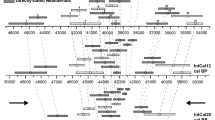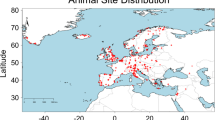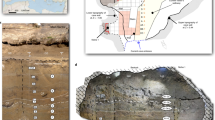Abstract
The timing of Neanderthal disappearance and the extent to which they overlapped with the earliest incoming anatomically modern humans (AMHs) in Eurasia are key questions in palaeoanthropology1,2. Determining the spatiotemporal relationship between the two populations is crucial if we are to understand the processes, timing and reasons leading to the disappearance of Neanderthals and the likelihood of cultural and genetic exchange. Serious technical challenges, however, have hindered reliable dating of the period, as the radiocarbon method reaches its limit at ∼50,000 years ago3. Here we apply improved accelerator mass spectrometry 14C techniques to construct robust chronologies from 40 key Mousterian and Neanderthal archaeological sites, ranging from Russia to Spain. Bayesian age modelling was used to generate probability distribution functions to determine the latest appearance date. We show that the Mousterian ended by 41,030–39,260 calibrated years bp (at 95.4% probability) across Europe. We also demonstrate that succeeding ‘transitional’ archaeological industries, one of which has been linked with Neanderthals (Châtelperronian)4, end at a similar time. Our data indicate that the disappearance of Neanderthals occurred at different times in different regions. Comparing the data with results obtained from the earliest dated AMH sites in Europe, associated with the Uluzzian technocomplex5, allows us to quantify the temporal overlap between the two human groups. The results reveal a significant overlap of 2,600–5,400 years (at 95.4% probability). This has important implications for models seeking to explain the cultural, technological and biological elements involved in the replacement of Neanderthals by AMHs. A mosaic of populations in Europe during the Middle to Upper Palaeolithic transition suggests that there was ample time for the transmission of cultural and symbolic behaviours, as well as possible genetic exchanges, between the two groups.
This is a preview of subscription content, access via your institution
Access options
Subscribe to this journal
Receive 51 print issues and online access
$199.00 per year
only $3.90 per issue
Buy this article
- Purchase on Springer Link
- Instant access to full article PDF
Prices may be subject to local taxes which are calculated during checkout



Similar content being viewed by others
References
Mellars, P. Neanderthals and the modern human colonization of Europe. Nature 432, 461–465 (2004)
d’Errico, F., Zilhão, J., Julien, M., Baffier, D. & Pelegrin, J. Neanderthal acculturation in western Europe? A critical review of the evidence and its interpretation. Curr. Anthropol. 39, S1–S44 (1998)
Higham, T. European Middle and Upper Palaeolithic radiocarbon dates are often older than they look: problems with previous dates and some remedies. Antiquity 85, 235–249 (2011)
Lévêque, F. & Vandermeersch, B. Découverte de restes humains dans le niveau Castelperronien à Saint-Césaire (Charente-Maritime). C.R. Acad. Sc. Paris 291, 187–189 (1980)
Benazzi, S. et al. Early dispersal of modern humans in Europe and implications for Neanderthal behaviour. Nature 479, 525–528 (2011)
Villa, P. & Roebroeks, W. Neandertal demise: an archaeological analysis of the modern human superiority complex. PLoS ONE 9, e96424 (2014)
Green, R. E. et al. A draft sequence of the Neandertal genome. Science 328, 710–722 (2010)
Prüfer, K. et al. The complete genome sequence of a Neanderthal from the Altai Mountains. Nature 505, 43–49 (2014)
Lohse, K. & Frantz, L. A. Neandertal admixture in Eurasia confirmed by Maximum likelihood analysis of three genomes. Genetics 196, 1241–1251 (2014)
Wall, J. D. et al. Higher levels of Neanderthal ancestry in East Asians than in Europeans. Genetics 194, 199–209 (2013)
Bronk Ramsey, C., Higham, T., Bowles, A. & Hedges, R. Improvements to the pretreatment of bone at Oxford. Radiocarbon 46, 155–163 (2004)
Higham, T. G., Jacobi, R. M. & Bronk Ramsey, C. AMS radiocarbon dating of ancient bone using ultrafiltration. Radiocarbon 48, 179–195 (2006)
Bird, M. I. et al. Radiocarbon dating of ‘old’ charcoal using a wet oxidation-stepped combustion procedure. Radiocarbon 41, 127–140 (1999)
Higham, T., Ramsey, C. B., Karavanić, I., Smith, F. H. & Trinkaus, E. Revised direct radiocarbon dating of the Vindija G1 Upper Paleolithic Neandertals. Proc. Natl Acad. Sci. USA 103, 553–557 (2006)
Wood, R. E. et al. Radiocarbon dating casts doubt on the late chronology of the Middle to Upper Palaeolithic transition in southern Iberia. Proc. Natl Acad. Sci. USA 110, 2781–2786 (2013)
Pinhasi, R. et al. Revised age of late Neanderthal occupation and the end of the Middle Paleolithic in the northern Caucasus. Proc. Natl Acad. Sci. USA 108, 8611–8616 (2011)
Higham, T. et al. The chronology of the Grotte du Renne (France) and implications for the association of ornaments and human remains within the Châtelperronian. Proc. Natl Acad. Sci. USA 107, 20234–20239 (2010)
Hublin, J.-J. et al. Radiocarbon dates from the Grotte du Renne and Saint-Césaire support a Neandertal origin for the Châtelperronian. Proc. Natl Acad. Sci. USA 109, 18743–18748 (2012)
Slimak, L. et al. Late Mousterian persistence near the arctic circle. Science 332, 841–845 (2011)
Bronk Ramsey, C. Bayesian analysis of radiocarbon dates. Radiocarbon 51, 337–360 (2009)
Zilhão, J. & d’Errico, F. The chronology and taphonomy of the earliest Aurignacian and its implications for the understanding of Neanderthal extinction. J. World Prehist. 13, 1–68 (1999)
Finlayson, C. et al. Late survival of Neanderthals at the southernmost extreme of Europe. Nature 443, 850–853 (2006)
Douka, K. et al. On the chronology of the Uluzzian. J. Hum. Evol. 68, 1–13 (2014)
Mellars, P. A. Major issues in the emergence of modern humans. Curr. Anthropol. 30, 349–385 (1989)
Brock, F. et al. Current pretreatment methods for AMS radiocarbon dating at the Oxford Radiocarbon Accelerator Unit (ORAU). Radiocarbon 52, 103–112 (2010)
Douka, K. et al. Improved AMS 14C dating of shell carbonates using high-precision X-Ray Diffraction (XRD) and a novel density separation protocol (CarDS). Radiocarbon 52, 735–751 (2010)
Stuiver, M. & Polach, H. Discussion: reporting of 14C data. Radiocarbon 19, 355–363 (1977)
Wood, R. E., Bronk Ramsey, C. & Higham, T. F. G. Refining the ultrafiltration bone pretreatment background for radiocarbon dating at ORAU. Radiocarbon 52, 600–611 (2010)
Reimer, P. J. et al. IntCal13 and Marine13 radiocarbon age calibration curves 0–50,000 years cal BP. Radiocarbon 55, 1869–1887 (2013)
Acknowledgements
The Natural Environment Research Council (NERC) funded this work (NE/D014077/1). Additional funding was received from the Leverhulme Trust, through the Ancient Human Occupation of Britain (AHOB) project, the NRCF (NERC Radiocarbon Facility) programme, Keble College (Oxford) and the European Research Council. We thank our many collaborators and their excavation teams, and all staff at the Oxford Radiocarbon Accelerator Unit for their contribution to this work. Maps at −80 m below current sea level were produced by M. Devès and A. Scheder Black.
Author information
Authors and Affiliations
Contributions
T.H. and R.J. conceived the project. T.H. obtained funding and directed the project. T.H., R.W., K.D., F.B., C.B.R. and A.Ma. performed pre-treatment chemistry, AMS dating and Bayesian analysis using OxCal. T.H., R.W., K.D., L.B. and R.J. sampled materials for AMS dating. T.H. and K.D. wrote the paper and all co-authors contributed to the draft. K.D. and T.H. produced the figures and illustrations. R.J., L.B., M.C., A.A., J.B., C.B.-R., C.Be., C.Bo., P.B., M.C., N.J.C., C.D., A.F., B.G., P.G., A.G.-M., S.G., P.H., B.H., M.-J.I.-C., A.J., J.F.J.P., J.-M.M.-F., J.M., M.M., L.M., E.M., A.Mo., F.N., E.P., M.P., S.P., M.d.l.R., J.R.-S., A.R., D.S., P.S., L.S., J.S., N.S., A.V. and R.P. provided permits and archaeological samples, expertise on site sequences and prior data for the modelling.
Corresponding author
Ethics declarations
Competing interests
The authors declare no competing financial interests.
Supplementary information
Supplementary Information
This file contains Supplementary Methods, Supplementary Text and Data for Archaeological sites in France, Spain, Germany, Italy, Greece, Belgium, United Kingdom, Lebanon and Russia and Supplementary references (see contents list for details). (PDF 4451 kb)
Supplementary Data
This file contains Supplementary Data. (XLSX 16 kb)
Rights and permissions
About this article
Cite this article
Higham, T., Douka, K., Wood, R. et al. The timing and spatiotemporal patterning of Neanderthal disappearance. Nature 512, 306–309 (2014). https://doi.org/10.1038/nature13621
Received:
Accepted:
Published:
Issue Date:
DOI: https://doi.org/10.1038/nature13621
This article is cited by
-
More than a decade of genetic research on the Denisovans
Nature Reviews Genetics (2024)
-
Delayed increase in stone tool cutting-edge productivity at the Middle-Upper Paleolithic transition in southern Jordan
Nature Communications (2024)
-
Homo sapiens and Neanderthal Use of Space at Riparo Bombrini (Liguria, Italy)
Journal of Archaeological Method and Theory (2024)
-
Anatomically modern human in the Châtelperronian hominin collection from the Grotte du Renne (Arcy-sur-Cure, Northeast France)
Scientific Reports (2023)
-
High-resolution ecosystem changes pacing the millennial climate variability at the Middle to Upper Palaeolithic transition in NE-Italy
Scientific Reports (2023)
Comments
By submitting a comment you agree to abide by our Terms and Community Guidelines. If you find something abusive or that does not comply with our terms or guidelines please flag it as inappropriate.



